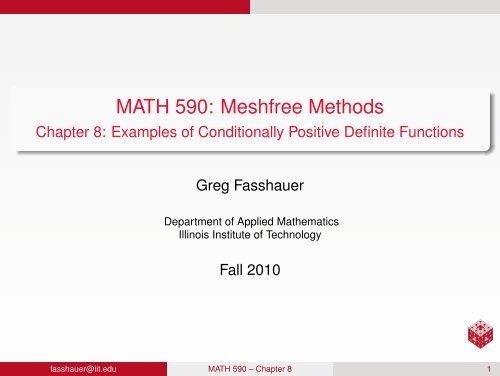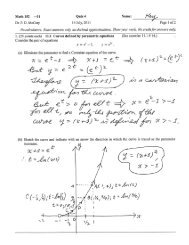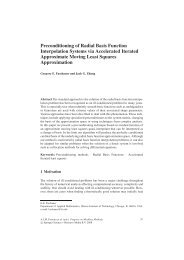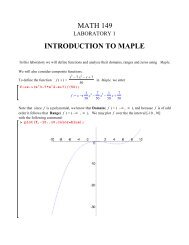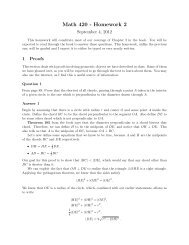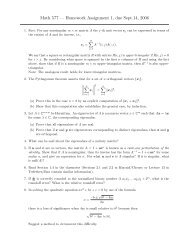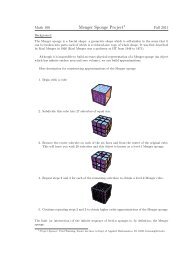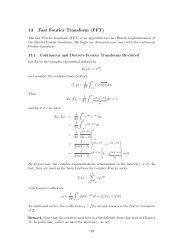MATH 590: Meshfree Methods - Chapter 8 - Illinois Institute of ...
MATH 590: Meshfree Methods - Chapter 8 - Illinois Institute of ...
MATH 590: Meshfree Methods - Chapter 8 - Illinois Institute of ...
- No tags were found...
You also want an ePaper? Increase the reach of your titles
YUMPU automatically turns print PDFs into web optimized ePapers that Google loves.
<strong>MATH</strong> <strong>590</strong>: <strong>Meshfree</strong> <strong>Methods</strong><strong>Chapter</strong> 8: Examples <strong>of</strong> Conditionally Positive Definite FunctionsGreg FasshauerDepartment <strong>of</strong> Applied Mathematics<strong>Illinois</strong> <strong>Institute</strong> <strong>of</strong> TechnologyFall 2010fasshauer@iit.edu <strong>MATH</strong> <strong>590</strong> – <strong>Chapter</strong> 8 1
Outline1 Example 1: Generalized Multiquadrics2 Example 2: Radial Powers3 Example 3: Thin Plate Splinesfasshauer@iit.edu <strong>MATH</strong> <strong>590</strong> – <strong>Chapter</strong> 8 2
We present some strictly conditionally positive definite (radial)functions that are covered by the Fourier transformcharacterization theorem <strong>of</strong> the previous chapter.fasshauer@iit.edu <strong>MATH</strong> <strong>590</strong> – <strong>Chapter</strong> 8 3
We present some strictly conditionally positive definite (radial)functions that are covered by the Fourier transformcharacterization theorem <strong>of</strong> the previous chapter.The generalized Fourier transforms for these examples areexplicitly computed in [Wendland (2005a)].fasshauer@iit.edu <strong>MATH</strong> <strong>590</strong> – <strong>Chapter</strong> 8 3
We present some strictly conditionally positive definite (radial)functions that are covered by the Fourier transformcharacterization theorem <strong>of</strong> the previous chapter.The generalized Fourier transforms for these examples areexplicitly computed in [Wendland (2005a)].Instead <strong>of</strong> going through these complicated calculations we willestablish the strict conditional positive definiteness <strong>of</strong> thesefunctions in the next chapter with the help <strong>of</strong> completely monotonefunctions.fasshauer@iit.edu <strong>MATH</strong> <strong>590</strong> – <strong>Chapter</strong> 8 3
We present some strictly conditionally positive definite (radial)functions that are covered by the Fourier transformcharacterization theorem <strong>of</strong> the previous chapter.The generalized Fourier transforms for these examples areexplicitly computed in [Wendland (2005a)].Instead <strong>of</strong> going through these complicated calculations we willestablish the strict conditional positive definiteness <strong>of</strong> thesefunctions in the next chapter with the help <strong>of</strong> completely monotonefunctions.The examples include some <strong>of</strong> the best known radial basicfunctions such asthe multiquadric due to [Hardy (1971)],and the thin plate spline due to [Duchon (1976)].fasshauer@iit.edu <strong>MATH</strong> <strong>590</strong> – <strong>Chapter</strong> 8 3
OutlineExample 1: Generalized Multiquadrics1 Example 1: Generalized Multiquadrics2 Example 2: Radial Powers3 Example 3: Thin Plate Splinesfasshauer@iit.edu <strong>MATH</strong> <strong>590</strong> – <strong>Chapter</strong> 8 4
Example 1: Generalized MultiquadricsGeneralized multiquadricΦ(x) = (1 + ‖x‖ 2 ) β , x ∈ R s , β ∈ R \ N 0 (1)fasshauer@iit.edu <strong>MATH</strong> <strong>590</strong> – <strong>Chapter</strong> 8 5
Example 1: Generalized MultiquadricsGeneralized multiquadricΦ(x) = (1 + ‖x‖ 2 ) β , x ∈ R s , β ∈ R \ N 0 (1)Generalized Fourier transformˆΦ(ω) = 21+βΓ(−β) ‖ω‖−β−s/2 K β+s/2 (‖ω‖), ω ≠ 0,<strong>of</strong> order m = max(0, ⌈β⌉).HereRemark⌈β⌉: smallest integer ≥ β,K ν : modified Bessel functions <strong>of</strong> the second kind <strong>of</strong> order νWe need to exclude β ∈ N 0 since this would lead to polynomials <strong>of</strong>even degree (see the related discussion in Example 2 and in HW 1).fasshauer@iit.edu <strong>MATH</strong> <strong>590</strong> – <strong>Chapter</strong> 8 5
Example 1: Generalized MultiquadricsSince the generalized Fourier transforms are positive with a singularity<strong>of</strong> order m at the origin, the FT characterization theorem from theprevious chapter tells us that the functionsΦ(x) = (−1) ⌈β⌉ (1 + ‖x‖ 2 ) β , 0 < β /∈ N,are strictly conditionally positive definite <strong>of</strong> order m = ⌈β⌉ (and higher).fasshauer@iit.edu <strong>MATH</strong> <strong>590</strong> – <strong>Chapter</strong> 8 6
Example 1: Generalized MultiquadricsSince the generalized Fourier transforms are positive with a singularity<strong>of</strong> order m at the origin, the FT characterization theorem from theprevious chapter tells us that the functionsΦ(x) = (−1) ⌈β⌉ (1 + ‖x‖ 2 ) β , 0 < β /∈ N,are strictly conditionally positive definite <strong>of</strong> order m = ⌈β⌉ (and higher).RemarkFor β < 0 the Fourier transform is a classical one and we are back tothe generalized inverse multiquadrics <strong>of</strong> <strong>Chapter</strong> 4.These functions are again shown to be strictly conditionally positivedefinite <strong>of</strong> order m = 0, i.e., strictly positive definite.fasshauer@iit.edu <strong>MATH</strong> <strong>590</strong> – <strong>Chapter</strong> 8 6
Example 1: Generalized MultiquadricsFigure: Hardy’s multiquadric with β = 1 2(left) and a generalized multiquadricwith β = 5 2 (right) centered at the origin in R2 .fasshauer@iit.edu <strong>MATH</strong> <strong>590</strong> – <strong>Chapter</strong> 8 7
Example 1: Generalized MultiquadricsFigure: Hardy’s multiquadric with β = 1 2(left) and a generalized multiquadricwith β = 5 2 (right) centered at the origin in R2 .RemarkThe generalized multiquadrics are no longer “bump” functions (as most<strong>of</strong> the strictly positive definite functions were), but functions that growwith the distance from the origin.fasshauer@iit.edu <strong>MATH</strong> <strong>590</strong> – <strong>Chapter</strong> 8 7
Example 1: Generalized MultiquadricsTogether with our earlier theorem on scattered data interpolation withconstant precision we have now established that we can use Hardy’smultiquadricsP f (x) =N∑c k√1 + ‖x − x k ‖ 2 + d, x ∈ R s ,k=1together with the constraintN∑c k = 0k=1to solve the scattered data interpolation problem.fasshauer@iit.edu <strong>MATH</strong> <strong>590</strong> – <strong>Chapter</strong> 8 8
Example 1: Generalized MultiquadricsTogether with our earlier theorem on scattered data interpolation withconstant precision we have now established that we can use Hardy’smultiquadricsP f (x) =N∑c k√1 + ‖x − x k ‖ 2 + d, x ∈ R s ,k=1together with the constraintN∑c k = 0k=1to solve the scattered data interpolation problem.The resulting interpolant will be exact for constant data.fasshauer@iit.edu <strong>MATH</strong> <strong>590</strong> – <strong>Chapter</strong> 8 8
Example 1: Generalized MultiquadricsWe can scale the basis functions with a shape parameter ε byreplacing ‖x‖ by |ε|‖x‖.fasshauer@iit.edu <strong>MATH</strong> <strong>590</strong> – <strong>Chapter</strong> 8 9
Example 1: Generalized MultiquadricsWe can scale the basis functions with a shape parameter ε byreplacing ‖x‖ by |ε|‖x‖.This does not affect the well-posedness <strong>of</strong> the interpolation problem.fasshauer@iit.edu <strong>MATH</strong> <strong>590</strong> – <strong>Chapter</strong> 8 9
Example 1: Generalized MultiquadricsWe can scale the basis functions with a shape parameter ε byreplacing ‖x‖ by |ε|‖x‖.This does not affect the well-posedness <strong>of</strong> the interpolation problem.A small value <strong>of</strong> ε gives rise to “flat” basis functions,whereas a large value <strong>of</strong> ε produces very narrow functions.fasshauer@iit.edu <strong>MATH</strong> <strong>590</strong> – <strong>Chapter</strong> 8 9
Example 1: Generalized MultiquadricsWe can scale the basis functions with a shape parameter ε byreplacing ‖x‖ by |ε|‖x‖.This does not affect the well-posedness <strong>of</strong> the interpolation problem.A small value <strong>of</strong> ε gives rise to “flat” basis functions,whereas a large value <strong>of</strong> ε produces very narrow functions.The accuracy <strong>of</strong> the fit will generally improve with decreasing εwhile the stability will tend to decrease, and the numerical resultswill become increasingly less reliable.RemarkFor the plots <strong>of</strong> the MQs we used the shape parameter ε = 1.fasshauer@iit.edu <strong>MATH</strong> <strong>590</strong> – <strong>Chapter</strong> 8 9
Example 1: Generalized MultiquadricsRemarkBy a theorem we will discuss below we can also solve the scattereddata interpolation problem using the simpler expansionP f (x) =N∑c k√1 + ‖x − x k ‖ 2 , x ∈ R s .k=1fasshauer@iit.edu <strong>MATH</strong> <strong>590</strong> – <strong>Chapter</strong> 8 10
Example 1: Generalized MultiquadricsRemarkBy a theorem we will discuss below we can also solve the scattereddata interpolation problem using the simpler expansionP f (x) =N∑c k√1 + ‖x − x k ‖ 2 , x ∈ R s .k=1This is what Hardy proposed to do in his work in the early 1970s (see,e.g., [Hardy (1971)]).fasshauer@iit.edu <strong>MATH</strong> <strong>590</strong> – <strong>Chapter</strong> 8 10
OutlineExample 2: Radial Powers1 Example 1: Generalized Multiquadrics2 Example 2: Radial Powers3 Example 3: Thin Plate Splinesfasshauer@iit.edu <strong>MATH</strong> <strong>590</strong> – <strong>Chapter</strong> 8 11
Example 2: Radial PowersRadial powersΦ(x) = ‖x‖ β , x ∈ R s , 0 < β /∈ 2N, (2)fasshauer@iit.edu <strong>MATH</strong> <strong>590</strong> – <strong>Chapter</strong> 8 12
Example 2: Radial PowersRadial powersΦ(x) = ‖x‖ β , x ∈ R s , 0 < β /∈ 2N, (2)Generalized Fourier transforms<strong>of</strong> order m = ⌈β/2⌉.ˆΦ(ω) = 2β+s/2 Γ( s+βΓ(−β/2)2 )‖ω‖ −β−s , ω ≠ 0,fasshauer@iit.edu <strong>MATH</strong> <strong>590</strong> – <strong>Chapter</strong> 8 12
Example 2: Radial PowersRadial powersΦ(x) = ‖x‖ β , x ∈ R s , 0 < β /∈ 2N, (2)Generalized Fourier transforms<strong>of</strong> order m = ⌈β/2⌉.Therefore, the functionsˆΦ(ω) = 2β+s/2 Γ( s+βΓ(−β/2)2 )‖ω‖ −β−s , ω ≠ 0,Φ(x) = (−1) ⌈β/2⌉ ‖x‖ β , 0 < β /∈ 2N,are strictly conditionally positive definite <strong>of</strong> order m = ⌈β/2⌉ (andhigher).fasshauer@iit.edu <strong>MATH</strong> <strong>590</strong> – <strong>Chapter</strong> 8 12
Example 2: Radial PowersThis shows that the basic function Φ(x) = −‖x‖ 2 used for thedistance matrix fits earlier are strictly conditionally positive definite<strong>of</strong> order one.fasshauer@iit.edu <strong>MATH</strong> <strong>590</strong> – <strong>Chapter</strong> 8 13
Example 2: Radial PowersThis shows that the basic function Φ(x) = −‖x‖ 2 used for thedistance matrix fits earlier are strictly conditionally positive definite<strong>of</strong> order one.According to the scattered data interpolation theorem from theprevious chapter we should have used these basic functionstogether with an appended constant.fasshauer@iit.edu <strong>MATH</strong> <strong>590</strong> – <strong>Chapter</strong> 8 13
Example 2: Radial PowersThis shows that the basic function Φ(x) = −‖x‖ 2 used for thedistance matrix fits earlier are strictly conditionally positive definite<strong>of</strong> order one.According to the scattered data interpolation theorem from theprevious chapter we should have used these basic functionstogether with an appended constant.However, another theorem below provides the justification for theiruse as a pure distance matrix.fasshauer@iit.edu <strong>MATH</strong> <strong>590</strong> – <strong>Chapter</strong> 8 13
Example 2: Radial PowersFigure: Radial cubic (left) and quintic (right) centered at the origin in R 2 .fasshauer@iit.edu <strong>MATH</strong> <strong>590</strong> – <strong>Chapter</strong> 8 14
Example 2: Radial PowersFigure: Radial cubic (left) and quintic (right) centered at the origin in R 2 .RemarkRadial cubics (β = 3) are strictly conditionally positive definite <strong>of</strong>order 2,quintics (β = 5) are strictly conditionally positive definite <strong>of</strong> order 3.fasshauer@iit.edu <strong>MATH</strong> <strong>590</strong> – <strong>Chapter</strong> 8 14
Example 2: Radial PowersRemarkWe had to exclude even powers in (2).fasshauer@iit.edu <strong>MATH</strong> <strong>590</strong> – <strong>Chapter</strong> 8 15
Example 2: Radial PowersRemarkWe had to exclude even powers in (2).This is clear since an even power combined with the square rootin the definition <strong>of</strong> the Euclidean norm results in a polynomial —and we have already decided that polynomials cannot be used forinterpolation at arbitrarily scattered multivariate sites.fasshauer@iit.edu <strong>MATH</strong> <strong>590</strong> – <strong>Chapter</strong> 8 15
Example 2: Radial PowersRemarkWe had to exclude even powers in (2).This is clear since an even power combined with the square rootin the definition <strong>of</strong> the Euclidean norm results in a polynomial —and we have already decided that polynomials cannot be used forinterpolation at arbitrarily scattered multivariate sites.Note that radial powers are not affected by a scaling <strong>of</strong> theirargument. In other words, radial powers are shape parameterfree.fasshauer@iit.edu <strong>MATH</strong> <strong>590</strong> – <strong>Chapter</strong> 8 15
Example 2: Radial PowersRemarkWe had to exclude even powers in (2).This is clear since an even power combined with the square rootin the definition <strong>of</strong> the Euclidean norm results in a polynomial —and we have already decided that polynomials cannot be used forinterpolation at arbitrarily scattered multivariate sites.Note that radial powers are not affected by a scaling <strong>of</strong> theirargument. In other words, radial powers are shape parameterfree.This has the advantage that the user need not worry about finding a“good” value <strong>of</strong> ε.fasshauer@iit.edu <strong>MATH</strong> <strong>590</strong> – <strong>Chapter</strong> 8 15
Example 2: Radial PowersRemarkWe had to exclude even powers in (2).This is clear since an even power combined with the square rootin the definition <strong>of</strong> the Euclidean norm results in a polynomial —and we have already decided that polynomials cannot be used forinterpolation at arbitrarily scattered multivariate sites.Note that radial powers are not affected by a scaling <strong>of</strong> theirargument. In other words, radial powers are shape parameterfree.This has the advantage that the user need not worry about finding a“good” value <strong>of</strong> ε.On the other hand, we will see below that radial powers will not beable to achieve the spectral convergence rates that are possiblewith some <strong>of</strong> the other basic functions such as Gaussians andgeneralized (inverse) multiquadrics.fasshauer@iit.edu <strong>MATH</strong> <strong>590</strong> – <strong>Chapter</strong> 8 15
Example 2: Radial PowersRemarkWe had to exclude even powers in (2).This is clear since an even power combined with the square rootin the definition <strong>of</strong> the Euclidean norm results in a polynomial —and we have already decided that polynomials cannot be used forinterpolation at arbitrarily scattered multivariate sites.Note that radial powers are not affected by a scaling <strong>of</strong> theirargument. In other words, radial powers are shape parameterfree.This has the advantage that the user need not worry about finding a“good” value <strong>of</strong> ε.On the other hand, we will see below that radial powers will not beable to achieve the spectral convergence rates that are possiblewith some <strong>of</strong> the other basic functions such as Gaussians andgeneralized (inverse) multiquadrics.If the even radial powers are multiplied by a log term, then we areback in business (see next example).fasshauer@iit.edu <strong>MATH</strong> <strong>590</strong> – <strong>Chapter</strong> 8 15
OutlineExample 3: Thin Plate Splines1 Example 1: Generalized Multiquadrics2 Example 2: Radial Powers3 Example 3: Thin Plate Splinesfasshauer@iit.edu <strong>MATH</strong> <strong>590</strong> – <strong>Chapter</strong> 8 16
Example 3: Thin Plate SplinesDuchon’s thin plate splines (or Meinguet’s surface splines)Φ(x) = ‖x‖ 2β log ‖x‖, x ∈ R s , β ∈ N, (3)fasshauer@iit.edu <strong>MATH</strong> <strong>590</strong> – <strong>Chapter</strong> 8 17
Example 3: Thin Plate SplinesDuchon’s thin plate splines (or Meinguet’s surface splines)Φ(x) = ‖x‖ 2β log ‖x‖, x ∈ R s , β ∈ N, (3)Generalized Fourier transforms<strong>of</strong> order m = β + 1.ˆΦ(ω) = (−1) β+1 2 2β−1+s/2 Γ(β + s/2)β!‖ω‖ −s−2βfasshauer@iit.edu <strong>MATH</strong> <strong>590</strong> – <strong>Chapter</strong> 8 17
Example 3: Thin Plate SplinesDuchon’s thin plate splines (or Meinguet’s surface splines)Φ(x) = ‖x‖ 2β log ‖x‖, x ∈ R s , β ∈ N, (3)Generalized Fourier transformsˆΦ(ω) = (−1) β+1 2 2β−1+s/2 Γ(β + s/2)β!‖ω‖ −s−2β<strong>of</strong> order m = β + 1.Therefore, the functionsΦ(x) = (−1) β+1 ‖x‖ 2β log ‖x‖, β ∈ N,are strictly conditionally positive definite <strong>of</strong> order m = β + 1.fasshauer@iit.edu <strong>MATH</strong> <strong>590</strong> – <strong>Chapter</strong> 8 17
Example 3: Thin Plate SplinesIn particular, we can use thin plate splinesN∑P f (x) = c k ‖x−x k ‖ 2 log ‖x−x k ‖+d 1 +d 2 x+d 3 y, x = (x, y) ∈ R 2 ,k=1together will the constraintsN∑c k = 0,k=1N∑c k x k = 0,k=1N∑c k y k = 0,k=1to solve the scattered data interpolation problem in R 2fasshauer@iit.edu <strong>MATH</strong> <strong>590</strong> – <strong>Chapter</strong> 8 18
Example 3: Thin Plate SplinesIn particular, we can use thin plate splinesN∑P f (x) = c k ‖x−x k ‖ 2 log ‖x−x k ‖+d 1 +d 2 x+d 3 y, x = (x, y) ∈ R 2 ,k=1together will the constraintsN∑c k = 0,k=1N∑c k x k = 0,k=1N∑c k y k = 0,k=1to solve the scattered data interpolation problem in R 2 provided thedata sites are not all collinear.fasshauer@iit.edu <strong>MATH</strong> <strong>590</strong> – <strong>Chapter</strong> 8 18
Example 3: Thin Plate SplinesIn particular, we can use thin plate splinesN∑P f (x) = c k ‖x−x k ‖ 2 log ‖x−x k ‖+d 1 +d 2 x+d 3 y, x = (x, y) ∈ R 2 ,k=1together will the constraintsN∑c k = 0,k=1N∑c k x k = 0,k=1N∑c k y k = 0,k=1to solve the scattered data interpolation problem in R 2 provided thedata sites are not all collinear.The resulting interpolant will be exact for data coming from a bivariatelinear function.fasshauer@iit.edu <strong>MATH</strong> <strong>590</strong> – <strong>Chapter</strong> 8 18
Example 3: Thin Plate SplinesFigure: “Classical” thin plate spline (left) and order 3 thin plate spline (right)centered at the origin in R 2 .fasshauer@iit.edu <strong>MATH</strong> <strong>590</strong> – <strong>Chapter</strong> 8 19
Example 3: Thin Plate SplinesRemark“Classical” thin plate splines (with β = 1) are strictly conditionallypositive definite <strong>of</strong> order 2,Φ(x) = ‖x‖ 4 log ‖x‖ (with β = 2) is strictly conditionally positivedefinite <strong>of</strong> order 3.fasshauer@iit.edu <strong>MATH</strong> <strong>590</strong> – <strong>Chapter</strong> 8 20
Example 3: Thin Plate SplinesRemark“Classical” thin plate splines (with β = 1) are strictly conditionallypositive definite <strong>of</strong> order 2,Φ(x) = ‖x‖ 4 log ‖x‖ (with β = 2) is strictly conditionally positivedefinite <strong>of</strong> order 3.Note that these functions are not monotone.Also, both graphs contain a portion with negative function values.fasshauer@iit.edu <strong>MATH</strong> <strong>590</strong> – <strong>Chapter</strong> 8 20
Example 3: Thin Plate SplinesAs with radial powers, use <strong>of</strong> a shape parameter ε in conjunctionwith thin plate splines is pointless.fasshauer@iit.edu <strong>MATH</strong> <strong>590</strong> – <strong>Chapter</strong> 8 21
Example 3: Thin Plate SplinesAs with radial powers, use <strong>of</strong> a shape parameter ε in conjunctionwith thin plate splines is pointless.The families <strong>of</strong> radial powers and thin plate splines are <strong>of</strong>tenreferred to collectively as polyharmonic splines.fasshauer@iit.edu <strong>MATH</strong> <strong>590</strong> – <strong>Chapter</strong> 8 21
Example 3: Thin Plate SplinesAs with radial powers, use <strong>of</strong> a shape parameter ε in conjunctionwith thin plate splines is pointless.The families <strong>of</strong> radial powers and thin plate splines are <strong>of</strong>tenreferred to collectively as polyharmonic splines.RemarkThere is no result that states that interpolation with thin plate splines(or any other strictly conditionally positive definite function <strong>of</strong> orderm ≥ 2) without the addition <strong>of</strong> an appropriate degree m − 1 polynomialis well-posed.fasshauer@iit.edu <strong>MATH</strong> <strong>590</strong> – <strong>Chapter</strong> 8 21
Example 3: Thin Plate SplinesAs with radial powers, use <strong>of</strong> a shape parameter ε in conjunctionwith thin plate splines is pointless.The families <strong>of</strong> radial powers and thin plate splines are <strong>of</strong>tenreferred to collectively as polyharmonic splines.RemarkThere is no result that states that interpolation with thin plate splines(or any other strictly conditionally positive definite function <strong>of</strong> orderm ≥ 2) without the addition <strong>of</strong> an appropriate degree m − 1 polynomialis well-posed.The later theorem mentioned several times before covers only thecase m = 1.fasshauer@iit.edu <strong>MATH</strong> <strong>590</strong> – <strong>Chapter</strong> 8 21
References IAppendixReferencesBuhmann, M. D. (2003).Radial Basis Functions: Theory and Implementations.Cambridge University Press.Fasshauer, G. E. (2007).<strong>Meshfree</strong> Approximation <strong>Methods</strong> with MATLAB.World Scientific Publishers.Iske, A. (2004).Multiresolution <strong>Methods</strong> in Scattered Data Modelling.Lecture Notes in Computational Science and Engineering 37, Springer Verlag(Berlin).Wendland, H. (2005a).Scattered Data Approximation.Cambridge University Press (Cambridge).fasshauer@iit.edu <strong>MATH</strong> <strong>590</strong> – <strong>Chapter</strong> 8 22
References IIAppendixReferencesDuchon, J. (1976).Interpolation des fonctions de deux variables suivant le principe de la flexion desplaques minces.Rev. Francaise Automat. Informat. Rech. Opér., Anal. Numer. 10, pp. 5–12.Hardy, R. L. (1971).Multiquadric equations <strong>of</strong> topography and other irregular surfaces.J. Geophys. Res. 76, pp. 1905–1915.fasshauer@iit.edu <strong>MATH</strong> <strong>590</strong> – <strong>Chapter</strong> 8 23


